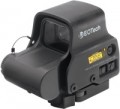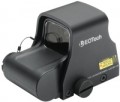—
Dust-, water protection. Protected housing that prevents dust and moisture from entering the delicate components of the sight. This feature is highly desirable if the sight is planned to be used in adverse conditions — for example, during a long hunting trip, where there is a chance of encountering bad weather. However it is worth considering that the specific degree of protection may be different, it should be clarified according to the documentation for the sight. However, almost all “protected” models are able to endure rain at least without problems.
—
Impact protection. Special protection that prevents damage to the sight during impacts and shocks — for example, by accidental falling or contact with a foreign object. The effectiveness of this protection may vary for different models, but in most cases it at least allows you to transfer the fall onto a hard surface from a height of 1 – 1.5 m. with a high probability it will turn out to be useless — the impact force will be much greater than that for which the device was originally designed. In addition, after any strong impact, the sight will have to be re-aligned. However, additional protection anyway improves the overall strength and reliability of the device.
—
Filling with gas. A feature that is found exclusively in sights with closed cases (see "Design"). Such cases are made airtight, and th
...e internal space in them is filled with an inert gas — for example, nitrogen — with a minimum content of water vapor. Thanks to this, the optical elements of the sight do not fog up from the inside, and metal parts do not oxidize due to contact with moisture. In addition, such an air-tight housing, by definition, is also dust and moisture resistant (see above).
— Rangefinder. A device that allows you to measure distances to objects visible in the scope. Do not confuse this function with rangefinder markings and other similar reticles (see “Reticle type”): in this case we are talking about a separate device, usually in the form of a laser rangefinder. Such equipment greatly simplifies measurements: there is no need to bother with special calculations for the angular dimensions of visible objects, just one click of a button is enough, and the accuracy of laser devices is very high — on the order of several centimeters at distances of hundreds of metres. The main disadvantage of this feature is the high cost; in addition, additional equipment increases the weight and dimensions of the sight. Therefore, built-in rangefinders are found exclusively in professional models designed for high-precision shooting.
— Level. A device that allows you to control the deviation of the sight (and, accordingly, the weapon) from the horizontal position — namely, the tilt to the right / left. Such a need arises primarily with high-precision shooting: even a slight slope, imperceptible to a person, can give a significant deviation, especially at a great distance. Levels may have a different design and principle of operation, but they are always set so that the shooter can see such an indicator at the same time as aiming. For example, in optics (see "Type"), a bubble bulb is placed above the lens or to the side of it, while in "night lights" and thermal imagers, data from an electronic sensor is projected directly into the eyepiece.
— Lantern. A flashlight mounted directly into the body or on the body of the sight. A rather specific function that is rare: at distances where optics are mainly used, a searchlight is needed, for "night lights" an IR illuminator is relevant (see below), collimators are more convenient to use with a separate underbarrel or hand "tactical" flashlight. However, the built-in lamp cannot be called completely useless. So, in optical sights, it is usually combined with a laser designator (see below), allowing you to effectively use the laser in low light conditions. And in the case of a collimator, the LEDs built into the frame are more compact than a separate underbarrel flashlight (which, moreover, can not be installed on every weapon that is compatible with a collimator).
— Laser designator(LTC). Device for quick aiming at short distances. The idea of such a device is extremely simple: a laser beam shows where the weapon is aimed, creating a clearly visible mark at the point of impact. This allows you to shoot accurately, even without looking into the main sight — including "from the hip" and from other emergency positions, which is especially useful in situations requiring maximum reaction speed. LCC is relevant only at minimum distances, but this is not a drawback, but a feature that can turn out to be a definite advantage. For example, a "laser" can be a great addition to a telescopic sight, which by itself is useless at short distances.
— Compatibility with night vision devices. Possibility of using the sight with separate night vision devices. Most often, this feature is found in collimator sights (see "Type") — it means that the brightness and colour of the collimator mark make it possible to clearly see it even through night vision devices. But optical models with such compatibility are extremely rare: firstly, it is technically difficult to implement, and secondly, for sniper shooting in the dark, there are specialized night and thermal imaging sights that are more convenient and effective than a combination of night vision devices with classic optics.
